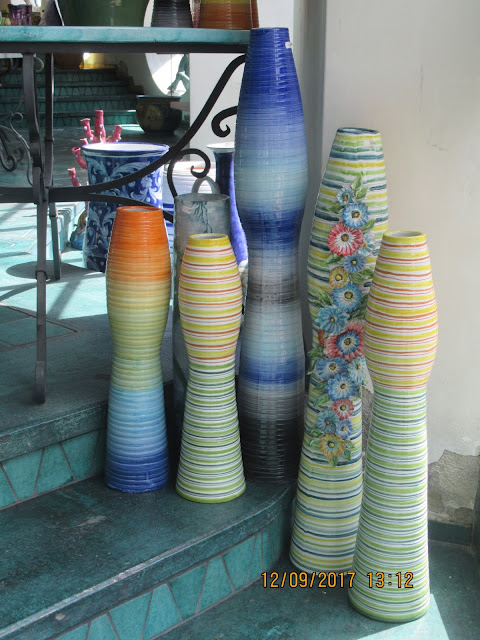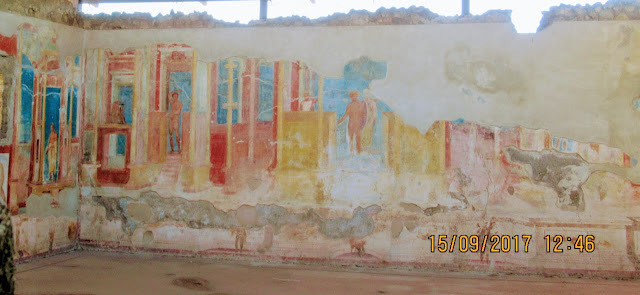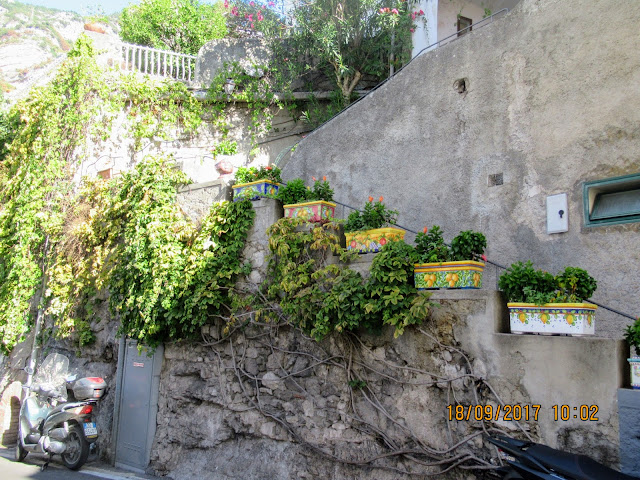There's so much to see and do in Italy that highlights of towns are all that I can manage.
In Salerno, we stayed in the old town. This is the most authentic old town we've been in. Yes, there are a few tourists wandering around, but most people live, love and work here. It's vibrant and noisy as cars and scooters clatter across the cobblestones and neighbours talk across alleys to one another.
Here we walk to the waterfront daily and witnessed water surging over a breakwater as a storm was gathering. We feared for the life of one man frantically bailing his little wooden boat...and later, after the storm, felt sad as we saw the beach littered with boat debris and counted half a dozen boats that had sunk.
A pretty little boat one day...
Here's the next day:
This man fell in his boat a few times as the sea surged at him over the breakwater and lost one bailing bucket. His friends were yelling at him to come in but he ignored their urgent commands. The next day we saw his little boat proudly floating.
We visited the interesting Minerva gardens (Giardino della Minerva). Every plant in the garden has some type of medicinal property to it. The garden was started by a physician back when the theory of healing was about the humours of the body and has been owned by the same family since the 12th century. This garden was built in tiers and had an ingenious system of transporting and storing water based on a cistern, gravity and water pressure. You could follow the water as it made its way through the garden.
The long staircases link one level of the garden to another.
The retaining wall on the left also has a trough to carry water.
This photo shows that a fountain is not just a fountain but is part of the system carrying the water to various parts of the garden.
A short ride on a SITA bus took us to the pretty little town of Vietri Sul Mare where beautiful ceramics are shipped all over the world, most famously those with their distinctive blue and yellow colours. Today the ceramicists make everything from traditional to very modern and from useful to merely decorative.
This is a huge factory where the ceramics are made, hand-painted, glazed, fired, sold to the public and shipped to customers worldwide:
The entire town is decorated in hand-painted ceramics. It's embedded in the walls around storefronts and in rectangles to form pictures, in the pots in public squares holding plants and in the ashtrays and garbage receptacles in the street...simply everywhere!
Some artists allow us to watch them work and we are surprised to see that they work in watercolours ... which are then both protected and come to life with the glazing and firing process.
The two-hour train ride from Salerno to Naples is comfortable; then the bus ride to the airport where we meet Mark and Carol.
For two nights we stay in a lovely agriturismo about 20 km outside of Naples. Dinner here one night was delicious, including the spectacular antipasti course that had many little delicacies over several plates. We could have stopped there and been satisfied...but we went on to a 'primo' course. Unlike the Italians, we could not order a 'secondi' or desert...just no room in our bellies.
Here we learned to travel the metro into town. We had tickets to a tour of the Naples underground and wanted to see a castle. What a circus...it took us a good two hours to find the meeting point for the tour. As we discovered later, the map downloaded with the ticket had one address but the marker on the map was in completely the wrong area. We ran into others also lost.
All of Naples is a geothermal area built on tuff, a sandstone formed from compressed layers of volcanic ash. It's strong but easy to work with. It was mined and the stones used for building, then 2500 years ago aqueducts were built to carry water, especially to homes of the wealthy.
More recently the caverns and underground caves were used as bomb shelters in WW II. These are children's toys abandoned after that period.
The humidity is often 100% here. University students are doing research on growing plants down here with lights, but no watering.
Everywhere underground footholds are carved for workers to get down into the underground and also to stay out of the water when straddling aqueduct routes.
While we ran out of time to see the castle, we saw parts of old town Naples that we would have missed had we gone directly there and the tour was very interesting.
This shop sells only tripe...not my favourite. Nonna (Italian for grandmother) used to make it for dad when we'd visit.
Fishmonger
After the tour, we found a little restaurant with good food, fascinating decor and great kitchen equipment like the meat slicer and pizza oven which were beautiful as well as functional.
Leaving Naples on the inexpensive but overcrowded, rattly Circumvensuvias train towards the Amalfi coast and our next Airbnb, we stop for a few hours at Pompeii. Two musicians board the train at one point with an accordion. They are surprisingly good and take our minds off the discomforts of standing room only with our loaded backpacks. We gladly tip them
Pompeii, a sophisticated Roman city was founded in 6 - 7th century BC. Mount Vesuvius erupted in 79 AD.
We walk our feet off on the old Roman cobblestones, see only a fraction of the site, but are blown away by the magnificence and scale of structures that were engineered.
We see casts of bodies frozen in motion as they were coated in lava ...and are awed by the force of nature that could wipe out entire cities in minutes. There are the homes, Roman baths, beautiful columns, statues, amphitheatres and frescoes.
Settled into our accommodation, buying food for four days and a good night's sleep later, we start out the next day for a bus ride down the Amalfi coast.
There really are no words to describe this trip. Hairpin curve after hairpin curve with a mountain on one side of the very narrow road and sheer cliff hundreds of meters on the other side. We look at the faces frozen in fear and with a death grip on the steering wheel of drivers passing us and are glad we are in the hands of a very competent bus driver. None the less 3 out of 4 of us are motion sick and woozy after the one hour ride.
We cannot imagine how people build and live, stacked one over the other on the face of the mountain like this.
Our destination was the little city of Amalfi which even now in mid-September is bursting with tourists.
A competitive rowing boat:
We walk up and over a big bump in the mountain through alleyways to people's homes, up and down countless stairs and arrive at the pretty little seaside village of Atrani. Here it's peaceful and the tourists are few. We enjoy lunch by the seaside.
Only Paul is eager to repeat the bus ride home, so we opt for the jet ferry, which is smooth and fast. Between waiting for ferries and buses, we don't get home until after dark. Fortunately, our meal of pasta with mussels and vegetables is quick to prepare.
After resting and cleaning up we decide to walk the two blocks to the town square of little Colli di Fontanella where we are staying. Its ten o'clock and the trattoria is busy pumping out delicious smelling BBQ meals, the ever-present wood-fired pizza and luscious dessert that we partake of along with a shot of either limoncello or grappa.
Morning of our third day dawns with rainfall which clears by noon, so out we head to explore Sorrento.
Today we head for Positano. We had hoped to do some hiking above the town but it takes more planning than we have the capacity for. Positano is the most touristy and expensive of the Amalfi towns that we've seen so far. We didn't run into George Clooney and family.
Ceramic chair
Ceramic tabletop
Off to Rome on the high-speed train.
































































































































No comments:
Post a Comment